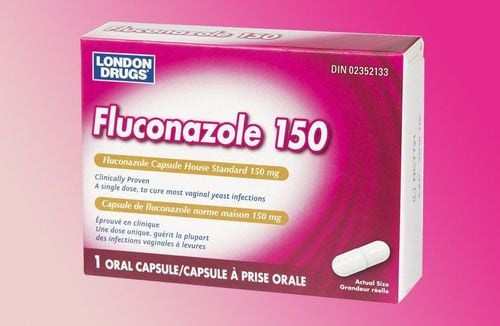This is an automatically translated article.
The article was professionally consulted with Specialist Doctor Obstetrician and Gynecologist - Department of Obstetrics and Gynecology - Vinmec Hai Phong International General Hospital.
When reaching puberty, a woman's vagina will secrete mucus, also known as vaginal discharge, and this is a normal physiological phenomenon that everyone experiences. However, vaginal discharge is not always normal, but there will be times when it's abnormal, making you worry about what's wrong with you and how to treat it?
1. What is bad breath?
Vaginal discharge is vaginal discharge, also known as white blood. Vaginal discharge marks the development and functioning of the female reproductive organs, when appearing from puberty and gradually decreasing at menopause. Normal discharge is white, chewy, odorless, or slightly fishy. The amount of vaginal discharge varies from person to person based on female hormone levels and decreases with age.
At each stage, a woman's vaginal discharge has specific characteristics such as:
Puberty to the end of adolescence: the period when vaginal discharge and menstruation begin. From 20 years old - menopause: the amount of secretion of a woman reaches the highest level between 20 and 30 years old and gradually decreases along with the decrease in female hormone levels. Post-menopause: At this stage, women often experience vaginal dryness because the level of estrogen levels decreases, causing the amount of discharge to also decrease.

2. Composition, properties, and role of gas
2.1. Composition and properties Vaginal discharge usually includes the following components: water, a mixture of alcohols and glycols, acetic acid, lactic acid, ketones, squalene, urea, pyridine, and aldehydes.
Vaginal discharge is usually slightly acidic, if you have some sexually transmitted diseases, the acidity in the white blood will be higher. According to research, vaginal discharge has a pH between 3.8 and 4.5.
2.2. The role of vaginal discharge in the female body Vaginal secretions act as a lubricant, helping to keep moisture and stabilize the genital environment to protect the vagina from the development of pathogens. In addition, this secretion also facilitates sperm to easily swim deep into the fallopian tube to fertilize.
A woman's private area is considered healthy if the vaginal discharge is completely normal. On the contrary, it can be a warning sign of many vaginal infections if the vaginal discharge has an unusual change in color or in the amount of discharge.
3. Normal vaginal discharge
Vaginal discharge is a vaginal discharge that occurs from puberty until menopause.
Vaginal discharge acts as a lubricant, moisturizing, stabilizing the genital environment, in order to limit the development of pathogens.
Vaginal discharge also creates a favorable environment for healthy sperm, easily swimming deep into the fallopian tubes to combine with eggs to fertilize.

Normal discharge will be white like egg white, tough, can be threaded, odorless or slightly fishy. Depending on the location, age, amount of estrogen in the body or menstrual cycle, each person will produce different amounts of vaginal discharge.
At the time of ovulation, before menstruation or, during pregnancy or at the time of sexual inspiration, women will produce more vaginal discharge than at other times.
In some of you, the discharge completely disappears, some have thick discharge until the next period, some other girls have thin discharge when they are about to menstruate.... These are all common changes. usually of vaginal discharge.
4. Manifestations of pathological vaginal discharge
If normal vaginal discharge is physiological vaginal discharge, a sign of good vaginal health, however, abnormal vaginal discharge is pathological discharge, indicating that signs of gynecological diseases in women have appeared.
The first and most recognizable change of abnormal discharge, warning of a problematic gynecological health condition, is an increase in the amount of discharge (a lot of discharge) along with changes in color and odor. or nature. Some cases may also be accompanied by other common unusual symptoms such as irritation, itching or burning around the private area and vagina.
Some signs of pathological vaginal discharge:
Vaginal discharge, white or thick like cheese Condition: Vaginal yeast infection Accompanied symptoms: Vaginal, vulvar itching, burning, pain or pain. Some patients may experience pain during sex and urination, along with redness and swelling of the vagina and vulva.

Vaginal discharge is white, yellow or gray Condition: Bacterial vaginosis Accompanying symptoms: Vaginal area has a fishy odor, itching, swelling. Vaginal discharge is yellow or green, thick Condition: Trichomonas infection Accompanying symptoms: Bad smell Brown, bloody discharge Condition: Irregular menstruation or diseases related to uterus, ovaries . Accompanying symptoms: Pelvic pain, vaginal bleeding Yellow or green vaginal discharge Condition: Gonorrhea Accompanied symptoms: Pelvic pain, urine with blood, pus
5. Causes of Pathological Discharge
Any slight change in the bacterial balance can affect the smell, color or texture of discharge. Some of the most common causes:
Bacterial vaginosis (Bacterial infections are more common in pregnant or sexually active women) Birth control pill use Cervical cancer Chlamydia or gonorrhea (STDs), diseases sexually transmitted infections) Fragrant soaps, lotions, lubricants Vaginal atrophy

6. Prevention of pathological vaginal discharge
Clean the intimate area: Avoid cleaning with dirty water or overuse of bad solutions that cause inflammation.
Safe sex: It should be noted that in the process of having sex, it should be coordinated, having sex with a method of prevention, and having a faithful relationship with a partner.
Reasonable diet: Regularly eat foods such as green vegetables, foods containing many nutrients to provide the body with enough calcium. In addition, you should also regularly exercise and do sports.
Wear 100% cotton underwear and avoid wearing clothes that are too tight.
When you notice abnormal vaginal discharge, you should go to a specialized medical facility to be examined by a doctor, determine the cause of the disease, and then treat it correctly and promptly, avoiding the condition of the disease. become heavier.
In order to help customers detect and treat other gynecological diseases early, Vinmec International Hospital has a basic gynecological examination and screening package, helping customers detect early inflammatory diseases Easy, inexpensive treatment. Screening detects gynecological cancer (cervical cancer) early even when there are no symptoms.
Basic gynecological examination and screening package for female customers, has no age limit and may have the following symptoms:
Abnormal vaginal bleeding Having menstrual problems: irregular menstrual cycle, irregular menstrual cycle Irregular vaginal discharge (smell, different color) Vaginal pain and itching Female clients have several risk factors such as poor personal hygiene, Unsafe sex, abortion,... Female customers have other symptoms such as: Abnormal vaginal discharge, itching, pain in the private area, abnormal vaginal bleeding.
Please dial HOTLINE for more information or register for an appointment HERE. Download MyVinmec app to make appointments faster and to manage your bookings easily.













